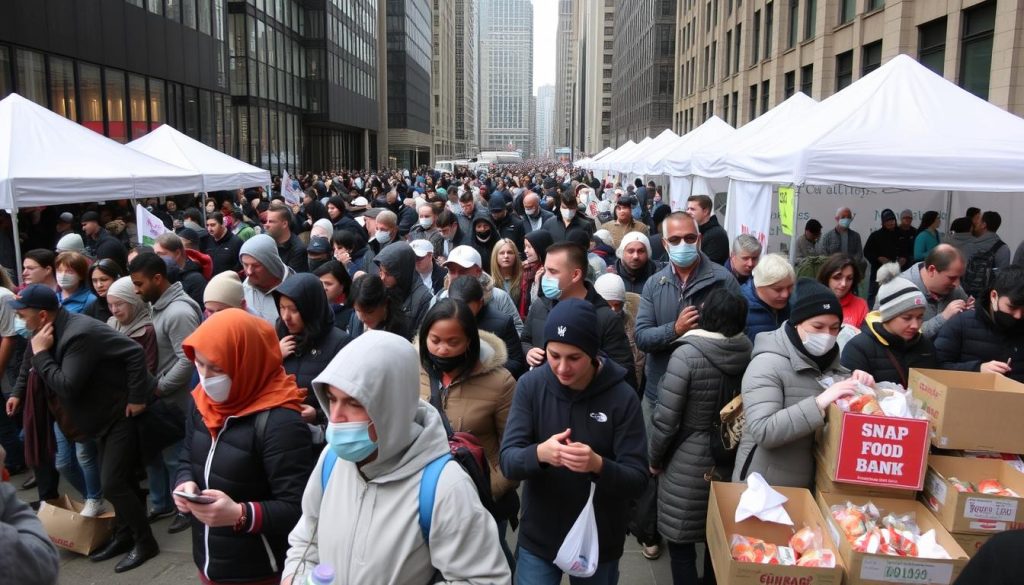No SNAP Benefits for 45 Million Americans on Nov 1st.
On November 1st, an abrupt halt in SNAP Benefits will affect 45 million Americans, escalating concerns over food insecurity.

The federal shutdown is now in its fifth week, and talks in Congress have hit a snag. Without new funds, SNAP Benefits will stop on November 1. This would leave about 42 to 45 million people without help to buy groceries, turning a budget crisis into a kitchen-table crisis.
Agriculture Secretary Brooke Rollins says the USDA lacks legal authority to keep payments flowing during the halt in government assistance. She also says contingency dollars cannot be tapped, even with about $5 billion sitting unused, because November needs an estimated $9.2 billion. As lines grow at food giveaways and paychecks go missing, World Central Kitchen, founded by José Andrés, is serving hot lunches to furloughed workers in Washington, D.C., at Canal Park and Navy Memorial Plaza.
On Capitol Hill, negotiations keep failing. Senate Majority Leader John Thune is pushing a full funding bill. At the same time, Senate Minority Leader Chuck Schumer plans a targeted measure to cover SNAP and WIC after USDA signaled benefits won’t go out on November 1. Vice President JD Vance says the administration found a way to cover military pay this week, but those workarounds do not apply to food assistance impacted by the shutdown. For millions, a SNAP benefits cut-off now looks imminent, as reported in coverage of the states’ court fight over halted food.
Advocates warn that proposed cuts could deepen the damage far beyond this month, with ripple effects on jobs and tax revenue, as noted in an analysis of the broader food stamp reductions. Without swift action, a snap benefit suspension on November 1 will strain families, grocers, and local food banks at once.
Key Takeaways
- SNAP Benefits are set to stop on November 1 without new federal funding.
- USDA says it cannot legally use contingency funds to prevent a snap benefit suspension.
- About 42–45 million people could see their SNAP benefits cut off during the shutdown.
- Local groups like World Central Kitchen are stepping in as food assistance needs grow.
- Senate leaders remain split between a full funding bill and targeted relief for SNAP and WIC.
- Analysts warn broader cuts could affect jobs, tax revenue, and grocery demand.
Why SNAP Benefits Are Being Halted and Who Is Affected
Millions depend on SNAP Benefits to eat. A funding lapse is causing changes in the program. Families, seniors, and workers face a risk of losing benefits.
Local pantries are seeing more people in need. Households are worried about missing payments.
Government shutdown triggers SNAP benefit suspension
The shutdown is now in its fifth week. USDA can’t send out November payments. Senate talks have stalled.
Minority Whip John Thune said no to single fixes. Majority Leader Chuck Schumer wants to fund SNAP and WIC. USDA says benefits won’t arrive on November 1.
Households are planning without a safety net. They worry about rent, utilities, and groceries. See this report on the shutdown vote failing.
USDA stance on contingency funds and legal availability
Agriculture Secretary Brooke Rollins says USDA can’t use contingency funds for November. She estimates $9.2 billion is needed. Alternative funds for the military and the FBI are not available for SNAP.
The legal line is clear: USDA can’t use emergency reserves without an appropriation. States have few options to help.
Scope of impact: roughly 42–45 million SNAP recipients nationwide
SNAP helps about 42 million people monthly. Some think it’s nearly 45 million. If payments stop, many will be affected.
Children, veterans, and workers in every state will be impacted. Grocery stores and farmers will also feel the effects.
Analysts say a halt in assistance will hurt food banks and clinics. Earlier debates on reducing SNAP show how fragile support can be. See a review of big cuts to SNAP food assistance.
States and D.C. are heading to court over the halt in government assistance halt
Twenty-five states and D.C. are suing the USDA to issue November benefits. They argue that the USDA must provide aid, even without a new funding bill. The case could decide if the emergency authority can prevent benefit loss during a shutdown.
Communities are preparing for more food insecurity. SNAP Benefits are at risk. Recipients are waiting to find out when their cards will be reloaded.
NO SNAP benefits for 45 million Americans on November 1st
USDA notices warn that, without a funding deal, there will be no SNAP Benefits loaded on November 1. This means no benefits for 45 million Americans on November 1st. Many households have already cut back on groceries.
Food banks expect lines to grow as the impacts of food assistance become a daily reality. This is due to a lack of funding.
Lawmakers remain at an impasse, and the Senate has failed to clear a stopgap. Advocates say a sudden snap benefits cut-off would hit families with children, older adults, and workers on uneven hours. Reporters tracking the shutdown note that paychecks are delayed and pantry demand is rising.
Legal challenges are mounting as 25 states and Washington, D.C., press the case for uninterrupted aid. They cite the scale of need. Coverage of these lawsuits and the scope—about 42 to 45 million people—can be seen in this overview of the states suing over SNAP.
Budget pressure deepens the squeeze. Analysts point to proposed federal trims and a tighter safety net. These factors leave food assistance impacted when a shutdown hits. For context on the funding shortfall facing November aid, see this explainer on how a shutdown leaves SNAP without cash on November 1.
Households are already planning around empty EBT cards, stretching meals, and delaying bills. If the snap benefits cut-off arrives, the average monthly grocery plan—often near $187—won’t bridge the gap. Ongoing debates about future appropriations, including proposals that show multiyear cuts, hint at a lasting strain on SNAP Benefits, with broader context in discussions of projected federal reductions.
Community groups from World Central Kitchen to local food pantries are scaling up midday meal sites. Families are bracing for a loss of SNAP benefits. Volunteers in Washington, D.C., report heavier turnout near transit hubs, while parents take grocery runs around free produce distributions. All signs point to food assistance being impacted across neighborhoods the moment the cards are not funded.
SNAP Benefits Conclusion
On November 1, SNAP Benefits face a sudden stop because Congress hasn’t passed a budget. The USDA says it can’t use emergency funds, and about $9.2 billion is needed for the month. This halt puts 42–45 million people at risk of losing access to grocery assistance, thereby increasing food insecurity.
In the Senate, leaders are divided. John Thune opposes quick fixes, while Chuck Schumer backs a Democratic bill to fund SNAP and WIC. After 13 failed House attempts and no vote, 25 states and D.C. are suing for payments. The USDA says workarounds for military pay don’t apply to SNAP changes.
Real-world signs are alarming: missed paychecks, longer food lines, and groups like World Central Kitchen helping in Washington, D.C., as CBS News reports. About 20 million households depend on this aid, and up to 45 million could be affected by a halt on November 1. This highlights the risks for families and retailers for SNAP Benefits.
Others say this would be the most significant cut to nutritional aid in U.S. history, at $186 billion over time. This shows the crisis’s scale and the need for quick action during the government assistance halt.
Without quick action from Congress or a court order, the cutoff will worsen food insecurity, disrupt grocery spending, and harm local economies. Households already face rent, utilities, and price increases. Clear funding and transparent SNAP changes are essential for stability now, before the damage grows and becomes harder to fix as shutdown ripple effects expand.







